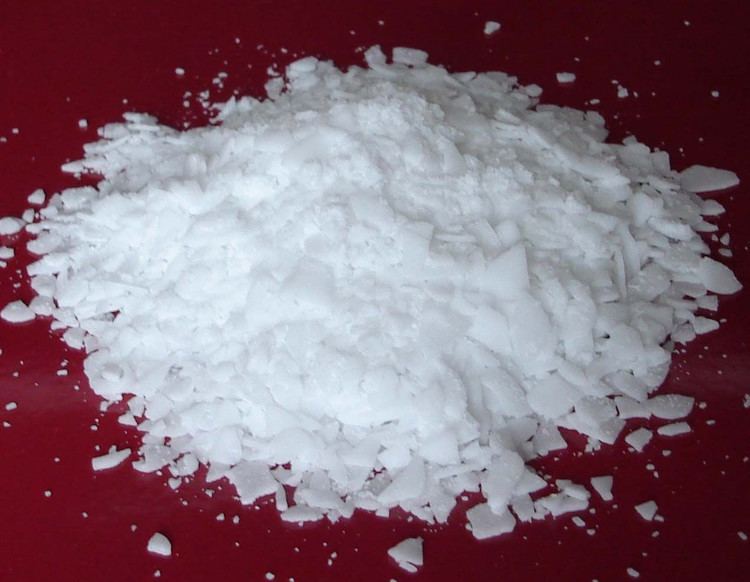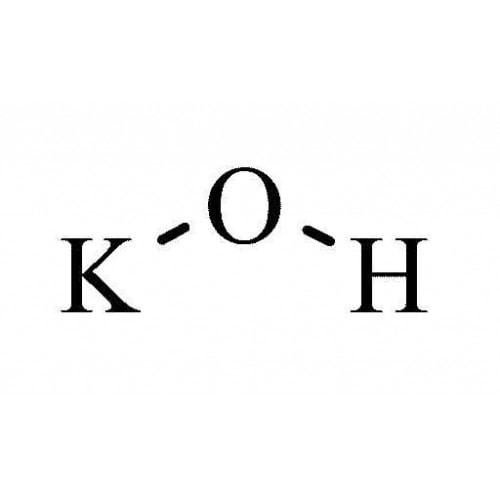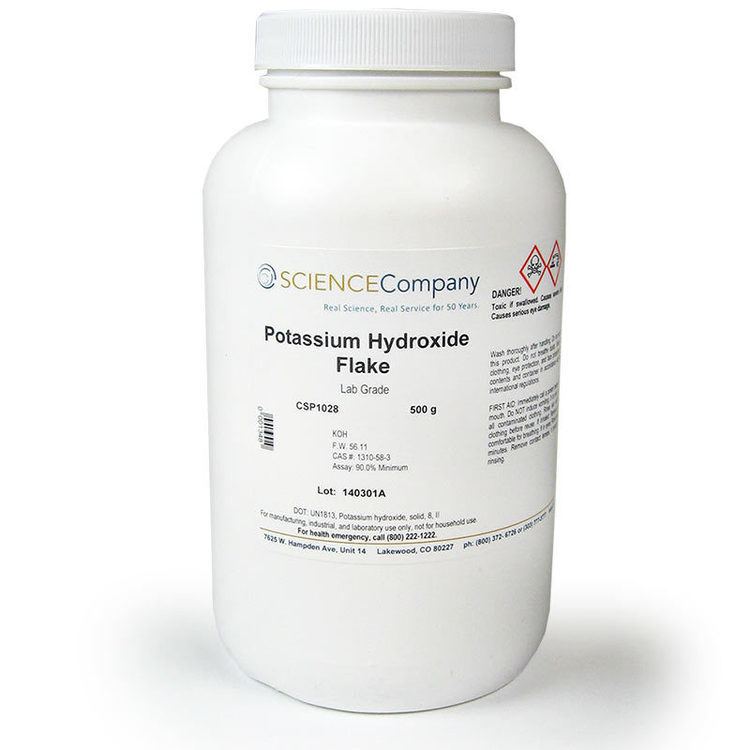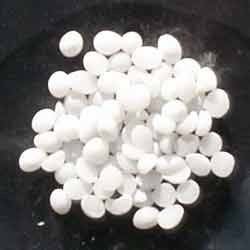Related compounds Molar mass 56.1056 g/mol Density 2.12 g/cm³ Boiling point 1,327 °C | Formula KOH IUPAC ID Potassium hydroxide Melting point 360 °C | |
 | ||
Appearance white solid, deliquescent | ||
Potassium carbonate to potassium hydroxide
Potassium hydroxide is an inorganic compound with the formula KOH, and is commonly called caustic potash.
Contents
- Potassium carbonate to potassium hydroxide
- Properties and structure
- Structure
- Solubility and desiccating properties
- Thermal stability
- As a base
- As a nucleophile in organic chemistry
- Reactions with inorganic compounds
- Manufacture
- Uses
- Precursor to other potassium compounds
- Manufacture of biodiesel
- Manufacture of soft soaps
- As an electrolyte
- Niche applications
- Petroleum refineries
- References
Along with sodium hydroxide (NaOH), this colorless solid is a prototypical strong base. It has many industrial and niche applications, most of which exploit its corrosive nature and its reactivity toward acids. An estimated 700,000 to 800,000 tonnes were produced in 2005. Approximately 100 times more NaOH than KOH is produced annually. KOH is noteworthy as the precursor to most soft and liquid soaps as well as numerous potassium-containing chemicals.

Properties and structure

Potassium hydroxide can be found in pure form by reacting sodium hydroxide with impure potassium. It is usually sold as translucent pellets, which will become tacky in air because KOH is hygroscopic. Consequently, KOH typically contains varying amounts of water (as well as carbonates, see below). Its dissolution in water is strongly exothermic. Concentrated aqueous solutions are sometimes called potassium lyes. Even at high temperatures, solid KOH does not dehydrate readily.

Potassium hydroxide solutions with concentrations of approximately 0.5 to 2.0% are irritating when coming into contact with the skin, while concentrations higher than 2% are corrosive.
Structure
At higher temperatures, solid KOH crystallizes in the NaCl crystal structure. The OH group is either rapidly or randomly disordered so that the OH−
group is effectively a spherical anion of radius 1.53 Å (between Cl−
and F−
in size). At room temperature, the OH−
groups are ordered and the environment about the K+
centers is distorted, with K+
—OH−
distances ranging from 2.69 to 3.15 Å, depending on the orientation of the OH group. KOH forms a series of crystalline hydrates, namely the monohydrate KOH·H
2O, the dihydrate KOH·2 H
2O, and the tetrahydrate KOH·4 H
2O.
Solubility and desiccating properties

Approximately 121 g of KOH will dissolve in 100 mL of water at room temperature compared with 100 g of NaOH in the same volume (on a molar basis, KOH is slightly less soluble than NaOH). Lower molecular weight alcohols such as methanol, ethanol, and propanols are also excellent solvents.

Because of its high affinity for water, KOH serves as a desiccant in the laboratory. It is often used to dry basic solvents, especially amines and pyridines: distillation of these basic liquids from a slurry of KOH yields the anhydrous reagent.
Thermal stability
Like NaOH, KOH exhibits high thermal stability. The gaseous species is dimeric. Because of its high stability and relatively low melting point, it is often melt-cast as pellets or rods, forms that have low surface area and convenient handling properties.
As a base
KOH is highly basic, forming strongly alkaline solutions in water and other polar solvents. These solutions are capable of deprotonating many acids, even weak ones. In analytical chemistry, titrations using solutions of KOH are used to assay acids.
As a nucleophile in organic chemistry
KOH, like NaOH, serves as a source of OH−
, a highly nucleophilic anion that attacks polar bonds in both inorganic and organic materials. In perhaps its most well-known reaction, aqueous KOH saponifies esters:
When R is a long chain, the product is called a potassium soap. This reaction is manifested by the "greasy" feel that KOH gives when touched — fats on the skin are rapidly converted to soap and glycerol.
Molten KOH is used to displace halides and other leaving groups. The reaction is especially useful for aromatic reagents to give the corresponding phenols.
Reactions with inorganic compounds
Complementary to its reactivity toward acids, KOH attacks oxides. Thus, SiO2 is attacked by KOH to give soluble potassium silicates. KOH reacts with carbon dioxide to give bicarbonate:
KOH + CO2 → KHCO3Manufacture
Historically KOH was made by adding potassium carbonate (Potash) to a strong solution of calcium hydroxide (slaked lime), leading to a metathesis reaction which caused calcium carbonate to precipitate, leaving potassium hydroxide in solution:
Ca(OH)2 + K2CO3 → CaCO3 + 2 KOHFiltering off the precipitated calcium carbonate and boiling down the solution gives potassium hydroxide ("calcinated or caustic potash"). It was the most important method of producing potassium hydroxide until the late 19th century, when it was largely replaced by the current method of electrolysis of potassium chloride solutions. The method is analogous to the manufacture of sodium hydroxide (see chloralkali process):
2 KCl + 2 H2O → 2 KOH + Cl2 + H2Hydrogen gas forms as a by-product on the cathode; concurrently, an anodic oxidation of the chloride ion takes place, forming chlorine gas as a by-product. Separation of the anodic and cathodic spaces in the electrolysis cell is essential for this process.
Uses
KOH and NaOH can be used interchangeably for a number of applications, although in industry, NaOH is preferred because of its lower cost.
Precursor to other potassium compounds
Many potassium salts are prepared by neutralization reactions involving KOH. The potassium salts of carbonate, cyanide, permanganate, phosphate, and various silicates are prepared by treating either the oxides or the acids with KOH. The high Solubility of potassium phosphate is desirable in fertilizers.
Manufacture of biodiesel
Although more expensive than using sodium hydroxide, KOH works well in the manufacture of biodiesel by transesterification of the triglycerides in vegetable oil. Glycerin from potassium hydroxide-processed biodiesel is useful as an inexpensive food supplement for livestock, once the toxic methanol is removed.
Manufacture of soft soaps
The saponification of fats with KOH is used to prepare the corresponding "potassium soaps," which are softer than the more common sodium hydroxide-derived soaps. Because of their softness and greater solubility, potassium soaps require less water to liquefy, and can thus contain more cleaning agent than liquefied sodium soaps.
As an electrolyte
Aqueous potassium hydroxide is employed as the electrolyte in alkaline batteries based on nickel-cadmium, nickel-hydrogen, and manganese dioxide-zinc. Potassium hydroxide is preferred over sodium hydroxide because its solutions are more conductive. The Nickel Metal Hydride batteries in the Toyota Prius use a mixture of potassium hydroxide and sodium hydroxide. Nickel–iron batteries also use potassium hydroxide electrolyte.
Niche applications
Like sodium hydroxide, potassium hydroxide attracts numerous specialized applications, virtually all of which rely on its properties as a strong chemical base with its consequent ability to degrade many materials. For example, in a process commonly referred to as "chemical cremation" or "resomation," potassium hydroxide hastens the decomposition of soft tissues, both animal and human, to leave behind only the bones and other hard tissues. Entomologists wishing to study the fine structure of insect anatomy may use a 10% aqueous solution of KOH to apply this process.
In chemical synthesis, the choice between the use of KOH and the use of sodium hydroxide, NaOH, is guided by the solubility of the resulting salt.
The corrosive properties of potassium hydroxide make it a useful ingredient in agents and preparations that clean and disinfect surfaces and materials that can themselves resist corrosion by KOH.
KOH is also used for semiconductor chip fabrication. See also: anisotropic wet etching.
Potassium hydroxide is often the main active ingredient in chemical "cuticle removers" used in manicure treatments.
Because aggressive bases like KOH damage the cuticle of the hair shaft, potassium hydroxide is used to chemically assist the removal of hair from animal hides. The hides are soaked for several hours in a solution of KOH and water to prepare them for the unhairing stage of the tanning process. This same effect is also used to weaken human hair in preparation for shaving. Pre-shave products and some shave creams contain potassium hydroxide to force open the hair cuticle and to act as a hygroscopic agent to attract and force water into the hair shaft, causing further damage to the hair. In this weakened state, the hair is more easily cut by a razor blade.
Potassium hydroxide is used to identify some species of fungi. A 3–5% aqueous solution of KOH is applied to the flesh of a mushroom and the researcher notes whether or not the color of the flesh changes. Certain species of gilled mushrooms, boletes, polypores, and lichens are identifiable based on this color-change reaction.
Petroleum refineries
Potassium hydroxide is also used in petroleum and natural gas refining for removal of organic acids and sulfur compounds.
